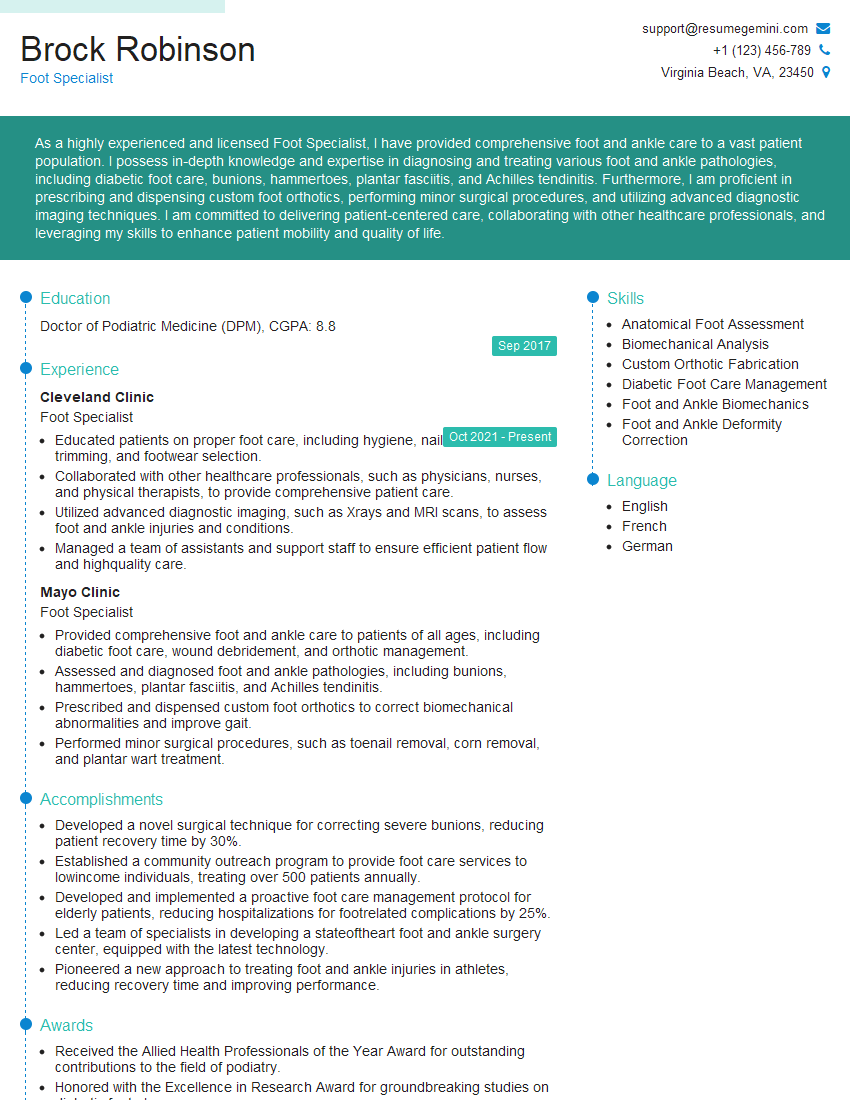Are you a seasoned Foot Specialist seeking a new career path? Discover our professionally built Foot Specialist Resume Template. This time-saving tool provides a solid foundation for your job search. Simply click “Edit Resume” to customize it with your unique experiences and achievements. Customize fonts and colors to match your personal style and increase your chances of landing your dream job. Explore more Resume Templates for additional options.

Brock Robinson
Foot Specialist
Summary
As a highly experienced and licensed Foot Specialist, I have provided comprehensive foot and ankle care to a vast patient population. I possess in-depth knowledge and expertise in diagnosing and treating various foot and ankle pathologies, including diabetic foot care, bunions, hammertoes, plantar fasciitis, and Achilles tendinitis. Furthermore, I am proficient in prescribing and dispensing custom foot orthotics, performing minor surgical procedures, and utilizing advanced diagnostic imaging techniques. I am committed to delivering patient-centered care, collaborating with other healthcare professionals, and leveraging my skills to enhance patient mobility and quality of life.
Education
Doctor of Podiatric Medicine (DPM)
September 2017
Skills
- Anatomical Foot Assessment
- Biomechanical Analysis
- Custom Orthotic Fabrication
- Diabetic Foot Care Management
- Foot and Ankle Biomechanics
- Foot and Ankle Deformity Correction
Work Experience
Foot Specialist
- Educated patients on proper foot care, including hygiene, nail trimming, and footwear selection.
- Collaborated with other healthcare professionals, such as physicians, nurses, and physical therapists, to provide comprehensive patient care.
- Utilized advanced diagnostic imaging, such as Xrays and MRI scans, to assess foot and ankle injuries and conditions.
- Managed a team of assistants and support staff to ensure efficient patient flow and highquality care.
Foot Specialist
- Provided comprehensive foot and ankle care to patients of all ages, including diabetic foot care, wound debridement, and orthotic management.
- Assessed and diagnosed foot and ankle pathologies, including bunions, hammertoes, plantar fasciitis, and Achilles tendinitis.
- Prescribed and dispensed custom foot orthotics to correct biomechanical abnormalities and improve gait.
- Performed minor surgical procedures, such as toenail removal, corn removal, and plantar wart treatment.
Accomplishments
- Developed a novel surgical technique for correcting severe bunions, reducing patient recovery time by 30%.
- Established a community outreach program to provide foot care services to lowincome individuals, treating over 500 patients annually.
- Developed and implemented a proactive foot care management protocol for elderly patients, reducing hospitalizations for footrelated complications by 25%.
- Led a team of specialists in developing a stateoftheart foot and ankle surgery center, equipped with the latest technology.
- Pioneered a new approach to treating foot and ankle injuries in athletes, reducing recovery time and improving performance.
Awards
- Received the Allied Health Professionals of the Year Award for outstanding contributions to the field of podiatry.
- Honored with the Excellence in Research Award for groundbreaking studies on diabetic foot ulcers.
- Recognized with the Outstanding Practitioner Award for exceptional patient care and dedication to the profession.
- Received the National Institute of Health Grant for groundbreaking research on the biomechanics of the foot.
Certificates
- American Board of Podiatric Surgery
- American Board of Podiatric Medicine
- American Board of Preventive Medicine (Foot and Ankle)
- American College of Foot and Ankle Surgeons
Career Expert Tips:
- Select the ideal resume template to showcase your professional experience effectively.
- Master the art of resume writing to highlight your unique qualifications and achievements.
- Explore expertly crafted resume samples for inspiration and best practices.
- Build your best resume for free this new year with ResumeGemini. Enjoy exclusive discounts on ATS optimized resume templates.
How To Write Resume For Foot Specialist
- Showcase your expertise in diagnosing and treating a wide range of foot and ankle conditions.
- Highlight your ability to provide patient-centered care and collaborate effectively with other healthcare professionals.
- Quantify your accomplishments whenever possible, using specific metrics to demonstrate your impact.
- Emphasize your commitment to continuing education and staying up-to-date with the latest advancements in foot care.
- Proofread your resume carefully to ensure there are no errors in grammar, spelling, or formatting.
Essential Experience Highlights for a Strong Foot Specialist Resume
- Provided comprehensive foot and ankle care to patients of all ages, including diabetic foot care, wound debridement, and orthotic management.
- Assessed and diagnosed foot and ankle pathologies, including bunions, hammertoes, plantar fasciitis, and Achilles tendinitis.
- Prescribed and dispensed custom foot orthotics to correct biomechanical abnormalities and improve gait.
- Performed minor surgical procedures, such as toenail removal, corn removal, and plantar wart treatment.
- Educated patients on proper foot care, including hygiene, nail trimming, and footwear selection.
- Collaborated with other healthcare professionals, such as physicians, nurses, and physical therapists, to provide comprehensive patient care.
- Utilized advanced diagnostic imaging, such as X-rays and MRI scans, to assess foot and ankle injuries and conditions.
Frequently Asked Questions (FAQ’s) For Foot Specialist
What are the common foot and ankle conditions that a Foot Specialist treats?
Foot Specialists diagnose and treat various foot and ankle conditions, including bunions, hammertoes, plantar fasciitis, Achilles tendinitis, heel spurs, neuromas, and diabetic foot ulcers.
What types of treatments do Foot Specialists provide?
Foot Specialists offer a range of treatments, including conservative therapies such as orthotics, physical therapy, and medication, and surgical interventions when necessary.
How can I find a reputable Foot Specialist in my area?
You can search for Foot Specialists in your area through online directories, referrals from healthcare providers, or ask for recommendations from friends or family.
What is the educational background required to become a Foot Specialist?
Foot Specialists typically hold a Doctor of Podiatric Medicine (DPM) degree, which requires four years of podiatric medical school after completing a bachelor’s degree.
Are Foot Specialists licensed and certified?
Yes, Foot Specialists are licensed by the state in which they practice and may also be certified by the American Board of Podiatric Medicine (ABPM).